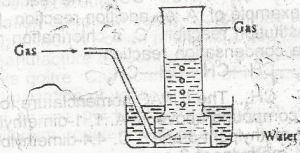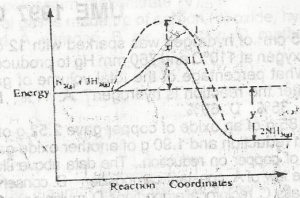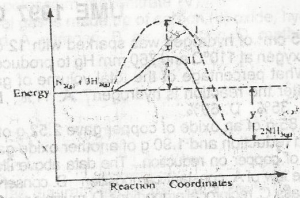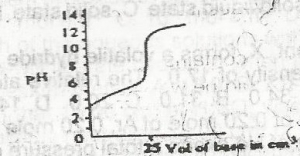Year :
1995
Title :
Chemistry
Exam :
JAMB Exam
Paper 1 | Objectives
41 - 45 of 45 Questions
| # | Question | Ans |
|---|---|---|
| 42. |
 The arrangement above can be used for the collection of A. sulphur (IV) oxide B. ammonia C. hydrogen chloride D. nitrogen Detailed SolutionThis apparatus can be seen either in the preparation of Nitrogen gas from AIR or from the reduction of Copper(II) Oxide by Ammonia in which Nitrogen gas is collected in the gas jar over water.Reaction Equation: \(3CuO_{(s)} + 2NH_{{3}{(g)}} \to 3Cu_{(s)} + 3H_{2}O_{(l)} + N_{{2}{(g)}}\) |
|
| 43. |
 The activation energy of the uncatalysed reaction is A. X B. X + Y C. X - Y D. Y |
A |
| 44. |
 It can be deduced that the rate of the reaction A. for bath l is higher than path ll B. for path ll is higher than path l C. is the same for both paths at all temperatures D. depends on the values of both x and y at all pressures |
B |
| 45. |
 The option above shows the PH changes for the titration of a A. strong acid versus strong base B. weak acid versus strong base C. strong acid versus weak base D. weak acid versus weak base |
A |
| 46. |
 The functional group represented in the compound above is? A. alkanol B. alkanal C. alkanone D. alanoate Detailed SolutionThe carbonyl group in tha alkanal (aldehyde) family is always at the end of a carbon chain |
| 42. |
 The arrangement above can be used for the collection of A. sulphur (IV) oxide B. ammonia C. hydrogen chloride D. nitrogen Detailed SolutionThis apparatus can be seen either in the preparation of Nitrogen gas from AIR or from the reduction of Copper(II) Oxide by Ammonia in which Nitrogen gas is collected in the gas jar over water.Reaction Equation: \(3CuO_{(s)} + 2NH_{{3}{(g)}} \to 3Cu_{(s)} + 3H_{2}O_{(l)} + N_{{2}{(g)}}\) |
|
| 43. |
 The activation energy of the uncatalysed reaction is A. X B. X + Y C. X - Y D. Y |
A |
| 44. |
 It can be deduced that the rate of the reaction A. for bath l is higher than path ll B. for path ll is higher than path l C. is the same for both paths at all temperatures D. depends on the values of both x and y at all pressures |
B |
| 45. |
 The option above shows the PH changes for the titration of a A. strong acid versus strong base B. weak acid versus strong base C. strong acid versus weak base D. weak acid versus weak base |
A |
| 46. |
 The functional group represented in the compound above is? A. alkanol B. alkanal C. alkanone D. alanoate Detailed SolutionThe carbonyl group in tha alkanal (aldehyde) family is always at the end of a carbon chain |